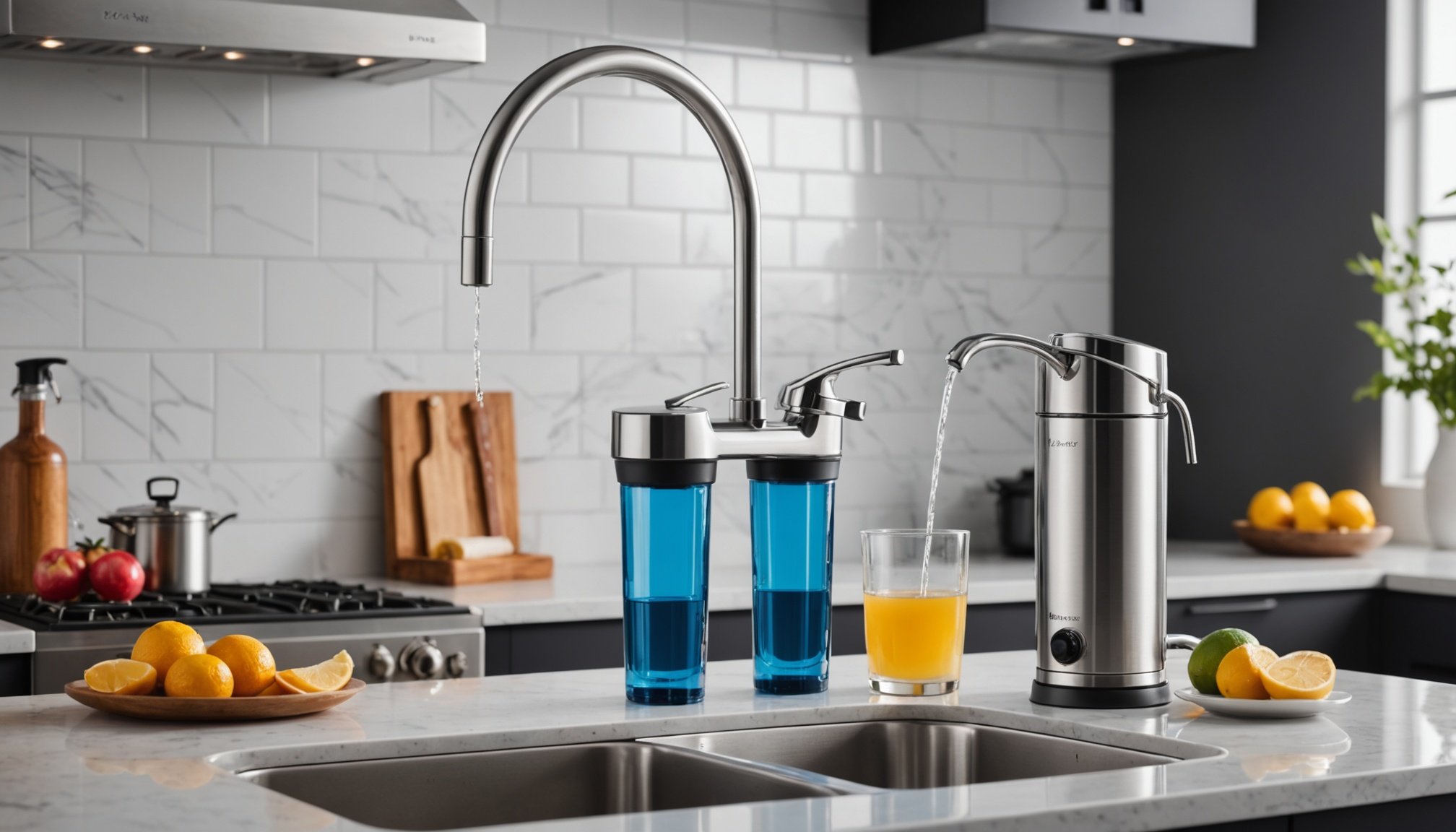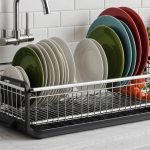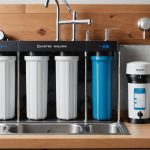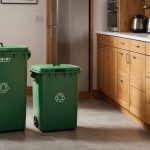Ultimate Kitchen Wellness: Your Comprehensive Guide to Effortlessly Installing a Water Filtration System
Why You Need a Water Filtration System
In today’s world, ensuring the quality of the water you drink is more crucial than ever. Tap water, despite being treated, can still contain a variety of contaminants such as heavy metals, pesticides, and even microplastics. A water filtration system is not just a luxury, but a necessity for maintaining your health and the health of your family.
“Water is the driving force of all nature,” as Leonardo da Vinci once said. However, the water coming out of your tap might not be as pure as you think. A filtration system can significantly improve the quality of your drinking water, making it safer and tastier.
This might interest you : Brilliant kitchen lighting: expert tips to reduce glare on surfaces for a perfect ambiance
Types of Water Filtration Systems
When it comes to choosing a water filtration system, you have several options, each with its own set of benefits and drawbacks.
Reverse Osmosis (RO) Systems
Reverse osmosis systems are among the most effective for removing a wide range of contaminants, including dissolved solids, bacteria, and viruses. These systems use a semi-permeable membrane to filter out impurities, resulting in very pure water.
This might interest you : The Ultimate Guide to Choosing the Ideal Kitchen Sink Size for Your Family’s Needs
Pros:
- Highly effective in removing contaminants
- Improves taste and odor
- Compact and easy to install under the sink
Cons:
- Can be slow
- Wastes some water during the filtration process
- May remove beneficial minerals from the water[5].
Activated Carbon Filters
Activated carbon filters are great for improving the taste and odor of your water. They are also effective in removing chlorine, lead, and volatile organic compounds (VOCs).
Pros:
- Inexpensive and easy to replace
- Improves taste and odor
- Effective in removing common contaminants
Cons:
- May not remove all contaminants, such as heavy metals and bacteria
- Needs regular replacement[4].
UV Purifiers
UV purifiers use ultraviolet light to kill bacteria, viruses, and other microorganisms. They are often used in conjunction with other filtration methods.
Pros:
- Effective in killing microorganisms
- Low maintenance
- Does not alter the taste or odor of the water
Cons:
- Does not remove dissolved solids or other contaminants
- Requires electricity to operate[3].
How to Choose the Best Water Filtration System for Your Home
Choosing the right water filtration system can be overwhelming, but here are some key factors to consider:
Water Quality
Understand the quality of your tap water by getting it tested. This will help you determine which contaminants you need to remove.
Space and Installation
Consider the space you have available under your sink or in your home. Some systems are more compact than others.
Maintenance and Replacement
Look for systems that are easy to maintain and have affordable replacement filters.
Budget
Determine how much you are willing to spend on the system and its ongoing maintenance.
Step-by-Step Guide to Installing a Water Filtration System
Installing a water filtration system is not as daunting as it seems. Here’s a step-by-step guide to help you through the process:
Pre-Installation Checks
- Shut Off the Water Supply: Locate the shut-off valves under the sink and turn them clockwise to shut off the water supply.
- Drain the System: Open the faucet to drain the water from the pipes.
Installing the Filter
- Mount the Filter: Follow the manufacturer’s instructions to mount the filter under the sink. This usually involves attaching it to the wall or the sink itself.
- Connect the Tubes: Connect the inlet and outlet tubes to the filter and the faucet. Make sure all connections are secure and not leaking.
Testing the System
- Turn On the Water Supply: Turn the shut-off valves counterclockwise to restore water supply.
- Check for Leaks: Turn on the faucet and check all connections for leaks.
- Run a Test Cycle: Run a few gallons of water through the system to ensure it is working correctly.
Maintenance and Replacement of Water Filtration Systems
To keep your water filtration system running efficiently, regular maintenance is crucial.
Regular Checks
- Check for Leaks: Regularly inspect the system for any signs of leaks.
- Replace Filters: Replace the filters according to the manufacturer’s schedule. This is usually every 6-12 months depending on usage.
Cleaning the System
- Flush the System: Periodically flush the system to remove any built-up contaminants.
- Clean the Faucet: Clean the faucet and any other parts that come into contact with filtered water.
Benefits of Using a Water Filtration System
Using a water filtration system offers numerous benefits for your health, your home, and the environment.
Improved Health
- Reduced Contaminants: Filtered water reduces the risk of waterborne diseases and exposure to harmful contaminants.
- Better Taste: Filtered water tastes better and is free from unpleasant odors.
Environmental Benefits
- Reduced Plastic Use: By using filtered tap water, you reduce the need for bottled water, thus reducing plastic waste.
- Energy Efficiency: Many filtration systems are energy-efficient and do not require electricity to operate.
Cost-Effective
- Long-Term Savings: While the initial cost of a filtration system may seem high, it saves you money in the long run by reducing the need for bottled water and extending the life of your appliances.
Comparison of Popular Water Filtration Systems
Here is a comparison of some popular water filtration systems to help you make an informed decision:
| System | Type | Effectiveness | Maintenance | Cost |
|---|---|---|---|---|
| iSpring RO System | Reverse Osmosis | High | Medium | $200-$300[5] |
| Berkey Filter | Gravity-Fed | High | Low | $300-$400[2] |
| Monderma Filter | Activated Carbon & UV | Medium-High | Medium | $200-$300[2] |
| Coldstream Filter | Activated Carbon & UV | Medium-High | Medium | $250-$350[2] |
Practical Insights and Actionable Advice
Tips for Optimal Performance
- Regularly Replace Filters: This ensures the system continues to perform at its best.
- Monitor Water Quality: Regularly test your water to ensure the system is removing all contaminants.
- Choose the Right System: Select a system that fits your specific needs and water quality issues.
Common Mistakes to Avoid
- Incorrect Installation: Follow the manufacturer’s instructions carefully to avoid leaks and other issues.
- Neglecting Maintenance: Regular maintenance is key to the longevity and effectiveness of the system.
- Overlooking Water Quality: Understand the quality of your tap water to choose the right filtration system.
Installing a water filtration system is a simple yet effective way to ensure the water in your home is safe, clean, and healthy. By understanding the different types of systems available, following a step-by-step installation guide, and maintaining your system regularly, you can enjoy the numerous benefits of filtered water.
As the saying goes, “You can’t buy happiness, but you can buy water filters, and that’s kind of the same thing.” Investing in a water filtration system is an investment in your health and well-being. So, take the first step today towards ultimate kitchen wellness.








